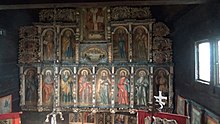Church of All Saints (Dobříkov)
The Church of All Saints (Czech Kostel Všech svatých , also Podkarpatský kostelík Všech svatých ) has been in the municipality of Dobříkov in the Czech Republic since 1930 . The original village church of Velká Kopaň near Sevljuš in Carpathian Russia has been repositioned twice since its existence, from 1857 to 1930 it stood in Cholmowets . It is one of the six Carpathian Russian wooden churches that were sold to Bohemia and Moravia within Czechoslovakia before World War II .
Building
The church is a timber construction made of oak planks with a tower and shingle roof of the Hungarian type of the Ruthenian folk construction. The church is divided into three parts: the anteroom ( babinec , rear part of the main nave, for the women), the main nave ( nava , for the men) and the presbytery (altar piece). The presbytery is separated from the nave by the iconostasis . The structure is 15 m long and 6 m wide. The tower height is 18 m.
The interior, the panel paintings on oak and linden wood and the rococo iconostasis come from Cholmowets and the broken church of Trosnyk ; the oldest pieces date from the 17th century. The driven door was designed and manufactured by the Masaryk Technical School Litomyšl .
history
The church was built in 1679 in the Ruthenian village of Welyka Kopanja and served as a place of worship for the Ruthenian community . Under the pastor Andrei Popovich, who worked in Welyka Kopanja from 1855 to 1893, the church was sold to Cholmowets in 1857 for 255 guilders .
The condition of the church deteriorated considerably at the beginning of the 1920s due to the partial dismantling of the altarpiece and the pyramid roofs. In the mid-1920s, the icons were taken from the dismantled wooden church of Šašvár .
After Senator Václav Klofáč learned of the church's decline, he bought the heavily damaged church for 16,000 Czechoslovak crowns in 1927. Klofáč commissioned the architect Adolf Kolena from Mukačevo with the dismantling of the church in Cholmovec , the transport of the parts to his place of residence Dobříkov, the repair and the reconstruction. The practical implementation of the implementation was carried out by the master carpenter Cyril Barlušek from Užhorod . On July 27, 1930, the parts arrived in Dobříkov by train from Carpathian Russia. The restoration of the original wall paintings was carried out by the Prague painter Vlastimil Košvanec , who also created some stained glass and the painting by Jan Hus and Johann Amos Comenius .
The consecration took place on July 6, 1931 by the Patriarch of the Czechoslovak Hussite Church Gustav Adolf Procházka in the presence of guests from all countries of Czechoslovakia.
In 1963 the church was added to the immovable cultural property register. It is owned by the Czechoslovak Hussite Church and belongs to the parish of Vysoké Mýto .
Web links
Individual evidence
Coordinates: 50 ° 0 ′ 4.4 ″ N , 16 ° 8 ′ 10.2 ″ E


